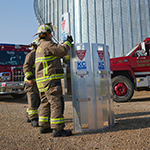Grain bin design and modifications
Grain bin safety features
If you’re a farmer who uses older bins to store grain on your farm, now is the time to replace existing storage assets to make your operation safer. When you’re considering a new bin, you can reduce the danger of suffocation and other safety hazards by incorporating the latest safety design features into the construction. These features can potentially save you from costly accidents or spills and even help save the lives of your employees.
Consider the following design features to help maintain grain flow and eliminate flow-stoppage incidents, keeping you and others from entering bins unnecessarily.
- Raised foundation. Constructing bins on a raised foundation will allow for a service tunnel with a 7-foot by 7-foot opening. Toward this end, you will be able to safely and conveniently loosen plugged grain and access conveyors and auger maintenance points — all from the bottom of the bin.
- Large sump holes. Installing larger sump holes in close proximity to each other on bin floors will help reduce clogging. On larger, commercial bins, consider installing a 36-inch center hole and 24-inch side holes every 8 to 10 feet.
- Proper ventilation. Selecting and correctly configuring the right ventilation system for your bins is important to proper grain management. Failure to do so can lead to spoilage, clogging and preventable bin entry.
- Zero-entry bin sweep. Sweep equipment should be installed in a way that does not require workers to be in the bin during operation.
If you must enter a bin, consider the following design features to help keep you and others safe while inside:
- Fixed anchor points. All bins should contain at least one fixed anchor point that can support 1,800 pounds and provide a 360-degree work area.
- Larger entry doors. Entry doors should be at least 24 inches or greater in diameter. A large door can better aid rescuers and help an observer gain a better inside view of the bin. If a door is 16 inches above the foundation, a step should be installed. If a door is 48 inches above the foundation, steps and a platform with railings should be installed.
- Larger roof openings. Roof openings should be at least 22 inches in diameter or 22 inches x 35 inches (oval). Larger openings provide easier access for rescuers and observers. If you have an overhead catwalk, your roof opening should be located either at the 1 o’clock or 5 o’clock position.
- Ladders. Vertical, fixed ladders should be accessible from the inside wall or roof opening to provide a path of escape in case of an emergency. Vertical ladders fixed on the outside wall should have appropriate ladders and safety cages or fall protection systems depending on local requirements. Roof ladders should be readily accessible from the vertical wall ladder fixed on the outside wall. Hand loop rails at the top of the vertical ladder, hand rails on the roof ladder and guard rails around the manhole are desirable safety features.
- Locks. Doors and other openings should be locked and secured at all times. This allows extra time to think before initial entry. You should also be able to turn off and padlock power switches, so nobody can turn on the power when others are in the bin.
- Safety decals. Post safety or warning decals at all entry points and other strategic locations on the bin.
Many grain operators question whether these new safety features can be retrofitted into their existing storage bins; The answer is somewhat nebulous. Grain bin modification remain a leading root cause of catastrophic structural failure in existing storage assets. Recognizing this, any modification, regardless of the perceived simplicity, should be carried out under the instruction of the grain bin manufacturer or a licensed design professional (such as a structural engineer with experience in bulk storage structures).

 >
>

 >
>
 >
>